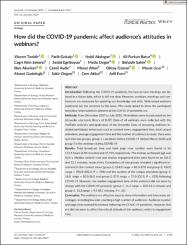How did the COVID-19 pandemic affect audience's attitudes in webinars?

View/
Access
info:eu-repo/semantics/openAccessDate
2021Author
Tanıdır, YılörenGökalp, Fatih
Akdoğan, Nebil
Batur, Ali Furkan
Şekerci, Çağrı Akın
Eğriboyun, Sedat
Değer, Mutlu
Ongün, Şakir
Metadata
Show full item recordAbstract
Introduction Following the COVID-19 pandemic, the face-to-face meetings are delayed to a future date, which is still not clear. However, seminars, meetings and conferences are necessary for updating our knowledge and skills. Web-based seminars (webinars) are the solutions to this issue. This study aimed to show the participant behaviour when webinars present at the COVID-19 pandemic era.
Methods From December 2017 to July 2020, 58 webinars were broadcasted via the Uropedia, electronic library of SUST. Data of all webinars were collected with the YouTube analytics and application of the Uropedia. Data of streaming webinars included participant behaviours such as content views, engagement time, total unique attendees, average engagement time and the number of audience to leads. Data were split into two groups; group-1 is webinars before COVID-19 (before March 2020) and group-2 is the webinars during COVID-19.
Results Total broadcast time and total page view number were found to be 112.6 hours (6761 minutes) and 15 919, respectively. The median participant age was 40.1 y. Median content view and median engagement time were found to be 261.0 and 12.2 minutes, respectively. Comparison of two groups revealed a significant increment in the content views (group-1; 134.0 range = 86.0-87.0 and group-2; 414.0 range = 296.0-602.0, P < .001) and the number of the unique attendees (group 1; 18.0 range = 10.0-26.0 and group-2; 57.0 range = 27.0-100.0, P < .001) following COVID-19. However, the median engagement time of the audience did not seem to change with the COVID-19 pandemic (group-1; 11.5 range = 10.0-13.3 minutes and group-2; 13.2 range = 9.4-18.1 minutes, P = .12).
Conclusion The webinars are effective ways to share information and have many advantages, including low cost, reaching a high number of audiences. Audience number and page visits seemed to increase following the COVID-19 pandemic. However, this era did not seem to affect the critical attitude of the audience, which is engagement time.

















